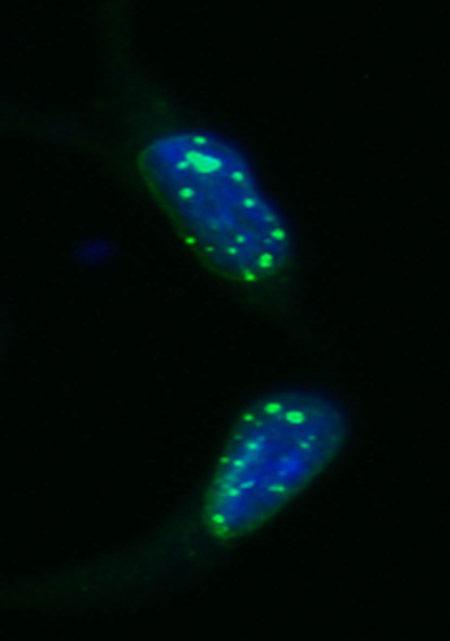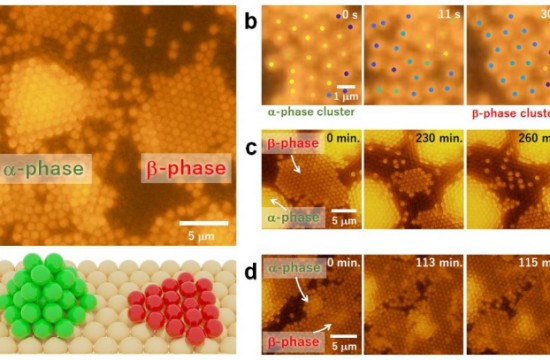
Duke University researchers have identified a common mechanism underlying separate forms of dystonia, a family of brain disorders that cause involuntary, debilitating and often painful movements, including twists and turns of different parts of the body.
Described online Dec. 8 in the journal Neuron, the research has also led to the development of a new cell-based screening test that is being deployed on a large scale to identify new drug candidates to treat dystonia.
“We’re excited to have found not only a new potential therapeutic inroad for multiple forms of dystonia, but also a mechanism that we think causes the disease,” said Nicole Calakos, M.D., Ph.D., an associate professor of neurology at Duke and a clinician who specializes in the care of patients with dystonia and other movement disorders.
Dystonia is the third most common movement disorder, after Parkinson’s disease and tremors. It is believed to affect 300 to 400 people per million population, and is more common in the elderly. The spectrum of dystonia’s many distinct forms include rare inherited cases like DYT1 dystonia, which is caused by a specific mutation in a single gene and leads to a severe disorder that arises in childhood. A larger proportion of cases, grouped into non-familial dystonia, have no known cause and tend to occur during adulthood.
In the new study, the team uncovered a mechanism for dystonia that links together rare inherited dystonia with the more common non-familial cases.
The path leading to this discovery started with a clinical observation more than six years ago. In 2009, Calakos became intrigued by a patient she had seen who had non-familial dystonia and harbored a rare variation in the same gene that causes childhood-onset DYT1 dystonia. This variant wasn’t exactly the same as the DYT1 mutation, but the research team wanted to figure out whether it could have contributed to the patient’s symptoms.
The mutation seemed to cause the DYT1 protein to be stuck near the cell’s nucleus, rather than where it should be in the cell’s protein-making factory, the endoplasmic reticulum. That’s the same misplacement of DYT1 found in childhood-onset dystonia. They published that case in the Journal of Medical Genetics in late 2009.
The coincidence of finding the same protein displacement in the two different kinds of dystonia planted the seed for a new way of thinking about the disorder, Calakos said.
In the new study, Duke neurobiology research analyst Zachary Caffall reasoned that if the DYT1 protein’s proper location within the cell meant the difference between health and disease, then it might be possible to search for new treatments using the mutant protein’s misplacement as tool for studying the disorder.
The idea was risky but it worked. Caffall was able to engineer a human cell line in which the DYT1 protein is misplaced near the nucleus with the flick of a chemical switch.
Using these cells, the team silenced each of 23,000 genes in the genome one by one to see which genes, when turned off, would correct the DYT1 protein’s location to the endoplasmic reticulum. Their tests hit a handful of genes that pointed to a molecular pathway called eIF2-alpha.
This pathway and related proteins respond to cell stress, such as that caused by misfolded proteins. And in the brain, eIF2-alpha is involved in adapting to experience by changing the strength of connections between brain cells. Problems with handling cell stress and brain adaptability are both thought to contribute to dystonia.
In another rare dystonia known as DYT16, the activity of the eIF2-alpha pathway is weaker than usual. And in the new study, Calakos’s team found that eIF2alpha activity is also lower in DYT1 patient samples.
Another piece of evidence connected non-familial dystonia with both DYT1 and DYT16 dystonia. Calakos happened to have additional data on her desk from several years earlier: sequences of protein-coding genes from a small group of patients with non-familial dystonia. Her team looked at these data again, spotting rare variations in an eIF2-alpha pathway gene in several patients who had a form of dystonia called torticollis, which causes the neck to twist.
Fortunately, numerous research groups and a National Institutes of Health-sponsored patient repository had already collected DNA from patients with torticollis. Pooling these data allowed Calakos’s team to quickly determine that the eIF2alpha pathway gene was much more frequently altered in individuals with dystonia than in the general population.
Calakos’s team is now collaborating with NIH scientists to deploy their cell-based assay to identify drug-like chemicals that correct the DYT1 protein’s location. So far, the researchers have screened more than 40,000 compounds.
Calakos’s lab is also developing better animal models of dystonia to understand how eIF2alpha pathway dysfunction affects the brain to cause dystonia.
Calakos said the screen would not have been possible without seed funding and continued support from a disease foundation started by an affected family that was willing to support “out-of-the-box” ideas.
Tyler’s Hope Foundation for a Dystonia Cure was started in 2006 by Rick and Michelle Staab, whose firstborn Tyler (now a 19-year-old college student) was diagnosed with dystonia at age 7. The couple’s daughter Samantha, now 15, was diagnosed on her seventh birthday. Their youngest, 11-year-old Luke, does not show symptoms but he has a 50% chance of having the gene. If he does have the gene, he has a 30% chance of having dystonia.
“We want to find a cure for our kids,” Rick Staab said. Of the money Tyler’s Hope raises, 97% funds high-risk, high-reward research. The Foundation is now supporting Calakos’s research in looking for new drugs with the screening assay.
“When we learned what our initial investment in Dr. Calakos’s research ultimately led to, we were extremely excited,” Staab said.
Source: dddmag








